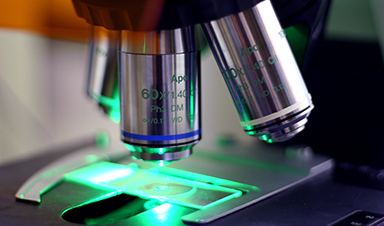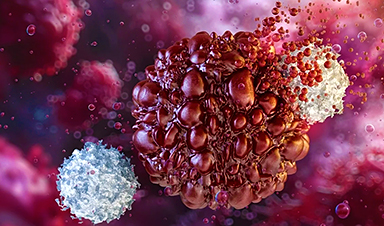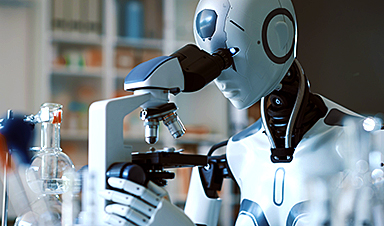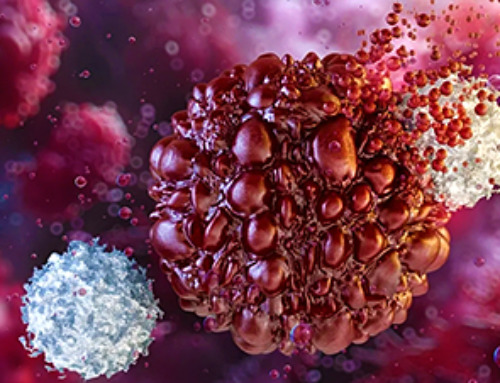Like our eyes, microscopes are limited in what they can see because of their resolution, or their ability to see detail. The detail, or information, from the object is there, but some of it gets lost as the light reflecting off of the object moves through the air.
“The whole premise of this is built on one single fact—the way light interacts with any matter is linear,” said Kamilov, assistant professor of electrical & systems engineering and computer science & engineering. “But the reality is that the interaction is actually not linear.”
For example, if you shine a flashlight through your hand, you can’t see the source of the light because it’s bending, and that is nonlinearity. With a single cell, the bending is so light that it is nearly transparent, which is linear.
When light interacts with a cell or an object, the light going out of the cell loses the information it gathers from that interaction. But because of that interaction, there are fluctuations in the vicinity of that cell that work with such matter and get retransformed and remitted. Those fluctuations are encoded into the nonlinearity of the interaction, but today’s microscopes are unable see this, Kamilov said.
“We want to take into account this nonlinear interaction of light, objects and premises, and if we do it correctly, we can extract that information, which normally disappears in a current microscope and is treated as ‘noise,'” Kamilov said. “We want to decode the information from the noise and add it back into the resolution, and that should give us features that are smaller than the resolution limit.”
Kamilov said there are two types of noise: imperfections and mathematical noise that is the result of science’s current limitations. It is the mathematical noise that he wants to capture.
Image Credit: Washington University in St. Louis
News This Week
Study Delivers Cancer Drugs Directly to the Tumor Nucleus
A new peptide-based nanotube treatment sneaks chemo into drug-resistant cancer cells, providing a unique workaround to one of oncology’s toughest hurdles. CiQUS researchers have developed a novel molecular strategy that allows a chemotherapy drug to [...]
Scientists Begin $14.2 Million Project To Decode the Body’s “Hidden Sixth Sense”
An NIH-supported initiative seeks to unravel how the nervous system tracks and regulates the body’s internal organs. How does your brain recognize when it’s time to take a breath, when your blood pressure has [...]
Scientists Discover a New Form of Ice That Shouldn’t Exist
Researchers at the European XFEL and DESY are investigating unusual forms of ice that can exist at room temperature when subjected to extreme pressure. Ice comes in many forms, even when made of nothing but water [...]
Nobel-winning, tiny ‘sponge crystals’ with an astonishing amount of inner space
The 2025 Nobel Prize in chemistry was awarded to Richard Robson, Susumu Kitagawa and Omar Yaghi on Oct. 8, 2025, for the development of metal-organic frameworks, or MOFs, which are tunable crystal structures with extremely [...]
Harnessing Green-Synthesized Nanoparticles for Water Purification
A new review reveals how plant- and microbe-derived nanoparticles can power next-gen water disinfection, delivering cleaner, safer water without the environmental cost of traditional treatments. A recent review published in Nanomaterials highlights the potential of green-synthesized nanomaterials (GSNMs) in [...]
Brainstem damage found to be behind long-lasting effects of severe Covid-19
Damage to the brainstem - the brain's 'control center' - is behind long-lasting physical and psychiatric effects of severe Covid-19 infection, a study suggests. Using ultra-high-resolution scanners that can see the living brain in [...]
CT scan changes over one year predict outcomes in fibrotic lung disease
Researchers at National Jewish Health have shown that subtle increases in lung scarring, detected by an artificial intelligence-based tool on CT scans taken one year apart, are associated with disease progression and survival in [...]
AI Spots Hidden Signs of Disease Before Symptoms Appear
Researchers suggest that examining the inner workings of cells more closely could help physicians detect diseases earlier and more accurately match patients with effective therapies. Researchers at McGill University have created an artificial intelligence tool capable of uncovering [...]














Leave A Comment